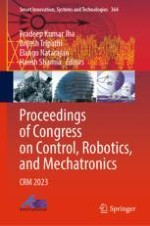This book features high-quality research papers presented at the International Conference of Mechanical and Robotic Engineering “Congress on Control, Robotics, and Mechatronics” (CRM 2023), jointly organized by Modi Institute of Technology, Kota, India, and Soft Computing Research Society, India, during 25–26 March 2023. This book discusses the topics such as combustion and fuels, controls and dynamics, fluid mechanics, I.C. engines and automobile engineering, machine design, mechatronics, rotor dynamics, solid mechanics, thermodynamics and combustion engineering, composite material, aerodynamics, aerial vehicles, missiles and robots, automatic design and manufacturing, artificial intelligence, unmanned aerial vehicles, autonomous robotic vehicles, evolutionary robotics, humanoids, hardware architecture, industrial robotics, intelligent control systems, microsensors and actuators, multi-robots systems, neural decoding algorithms, neural networks for mobile robots, space robotics, control theory and applications, model predictive control, variable structure control, and decentralized control.
